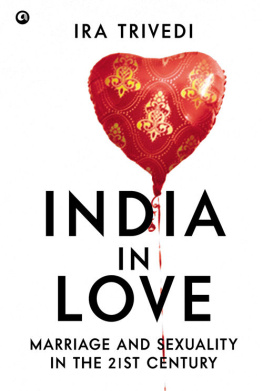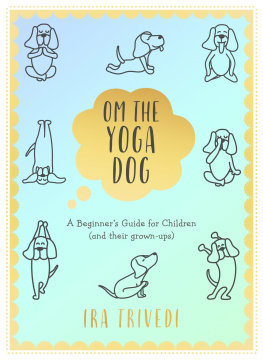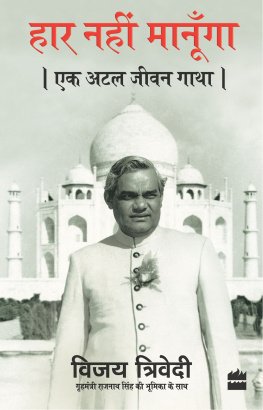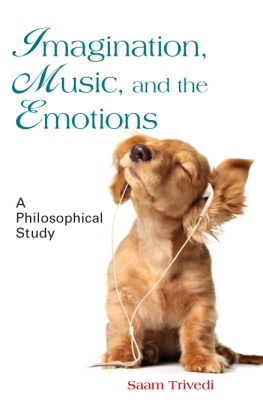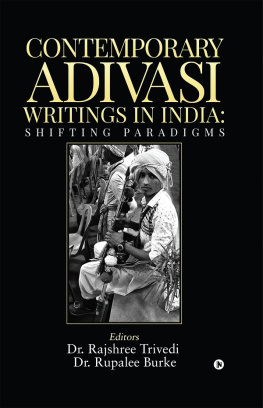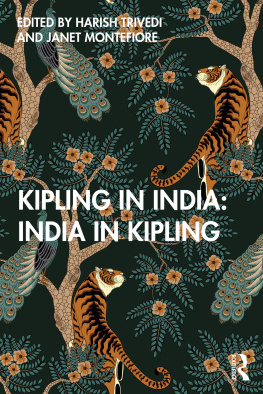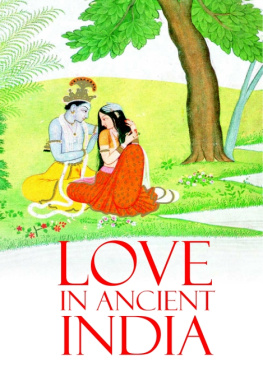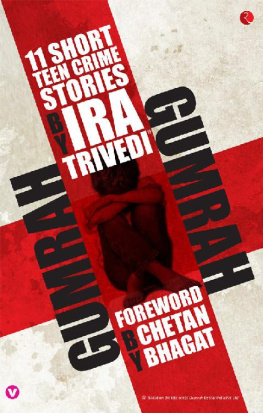Ira Trivedi - India in Love
Here you can read online Ira Trivedi - India in Love full text of the book (entire story) in english for free. Download pdf and epub, get meaning, cover and reviews about this ebook. year: 2014, genre: Home and family. Description of the work, (preface) as well as reviews are available. Best literature library LitArk.com created for fans of good reading and offers a wide selection of genres:
Romance novel
Science fiction
Adventure
Detective
Science
History
Home and family
Prose
Art
Politics
Computer
Non-fiction
Religion
Business
Children
Humor
Choose a favorite category and find really read worthwhile books. Enjoy immersion in the world of imagination, feel the emotions of the characters or learn something new for yourself, make an fascinating discovery.
- Book:India in Love
- Author:
- Genre:
- Year:2014
- Rating:3 / 5
- Favourites:Add to favourites
- Your mark:
- 60
- 1
- 2
- 3
- 4
- 5
India in Love: summary, description and annotation
We offer to read an annotation, description, summary or preface (depends on what the author of the book "India in Love" wrote himself). If you haven't found the necessary information about the book — write in the comments, we will try to find it.
India in Love — read online for free the complete book (whole text) full work
Below is the text of the book, divided by pages. System saving the place of the last page read, allows you to conveniently read the book "India in Love" online for free, without having to search again every time where you left off. Put a bookmark, and you can go to the page where you finished reading at any time.
Font size:
Interval:
Bookmark:

Also by Ira Trivedi
Theres No Love on Wall Street (2011)
The Great Indian Love Story (2009)
What Would You Do to Save the World? (2006)
ALEPH BOOK COMPANY
An independent publishing firm
promoted by Rupa Publications India
First published in India in 2014 by
Aleph Book Company
7/16 Ansari Road, Daryaganj
New Delhi 110 002
Copyright Ira Trivedi 2014
All rights reserved.
Some names have been changed to protect the identity and privacy of the people whose stories have been included.
No part of this publication may be reproduced, transmitted, or stored in a retrieval system, in any form or by any means, without permission in writing from Aleph Book Company.
ISBN: 978-93-83064-59-5
1 3 5 7 9 10 8 6 4 2
Printed and bound in India by
This book is sold subject to the condition that it shall not, by way of trade or otherwise, be lent, resold, hired out, or otherwise circulated without the publishers prior consent in any form of binding or cover other than that in which it is published.
For my beautiful parents,
Mona and Vishwapati Trivedi,
without whom there would be no words.
For the first time since the Vedic age one of the central pillars of Indian society and culturemarriageis undergoing drastic change as young adults increasingly choose to marry on their own terms, not settling for marriages that their families have arranged for them. Notions of love are changing as young people date with their parents sanction and have sex of their own volition. The relations between man and woman in this country have changed more in the past ten years than they have in the previous three thousand. Sex is beginning to escape from underneath the sheets and in to the living room. Traditionally, the mating game began with marriage (arranged by the family based purely on caste and economics) was followed by sex (usually for the first time) and then blossomed into love (if the couple was lucky). That convenient little formula is now being radically alteredfrom marriage, sex and then love, we are moving to love, sex (or vice-versa) and then, maybe, marriage. Many young Indians from the urban middle class are beginning to believe that love and sex are the only things that matter in relationships, particularly marriage. This unprecedented change in thinking has probably led to more fulfilling relationships than those of the past, but it has also led to multiple crises in our society.
Today, India is at the first stage of a major social revolution. This was catalysed by the explosive economic changes of the past few decades that accelerated the slow cultural change that was already in the making. Now our country is entering uncharted territory. Most notions related to love and marriage, which were pertinent to our parents and their ancestors, are changing in the modern age. Arranged marriages are shattering, divorce rates soaring and new paradigms of sex and relationshipsqueer, open, and live-inare being tested and explored. New values are feverishly in the making, and we live in a state of molten confusion.
The sexual and marriage revolutions are happening simultaneously; it is a circular process rather than the linear progression of the sexual and marriage revolutions that were seen in the West. In Indias revolution, the emancipation of women, the break-up of the family as the central economic unit, the redefinition of sexual mores, the shift from arranged marriage to love marriage is all happening at the very same time. This sort of change, happening at cyber-speed, is bound to be turbulent.
Through the course of this book we will hear tales of modern India, an India that is being reinvented on the run by the rise of a newly minted Great Indian Middle Class eager to fit into a globalized world. It will seek to provide a cutting-edge, incisive evaluation of how marriage, sexuality and love work in contemporary, urban India.
When I set out to write this book, what I was really interested in were the groups who were driving the changing attitudes to sex and sexuality in modern times, and these were primarily young, urban and middle class. I travelled to all of Indias metros and a dozen other cities to collect information and form impressions of the changes that are taking place. I became convinced that I needed to probe deeply into middle-class attitudes towards my subject, because what the middle class thinks and feels today will become the norm tomorrow, especially given the way the world is evolving. In other words, in roughly a quarter of a century, or in the course of another generation, India will have added one billion people to the middle classalmost double its current population.
It is this middle class that will finally break through the age-old caste system of India. The similarities amongst Indias middle class across the country are greater and perhaps more binding than the traditional forces of caste and religion that have shaped the country for millennia. While change has been slow to happen until now, there are signs that economic growth and education are helping to bring down age-old social barriers.
Focusing on an I strongly believe that urban youth are the early adopters of most trends especially when it pertains to lifestyle trends. Aspirational rural youth, in their turn, crave the lifestyle of their urban counterparts and it is becoming less difficult and more enticing to move to the city. The geographic pattern of Indias income and consumption growth is shifting too.
India is also one of the worlds youngest countries and its sexual revolution too is of the young. Indias current population includes 315 million people who are under twenty-five It is an unprecedented demographic condition in its history, and in absolute numbers it is unprecedented anywhere in the world. This demographic dividend is driving this revolution along with other factors, and will continue to drive it in the future.
As a result of technological, economic, political and legislative changes over the past decade, the choices, freedom and experiences of the present generation have been radically different from everything that has preceded them. Technology in particular has been a major game changer. Cable television, Facebook, Twitter, YouTube, chat rooms, online porn and the like have teased the imagination of a young India, expanding her horizons and aspirations with the click of a button. India already has the third largest internet user base, 100 million people strong, just behind China and the USA. In the next three years the number of internet users is expected to be in excess of 300 million. Economic development has aided the sexual revolution too, with consumerism being an integral part of it. With further industrial development, rural to urban migration, nuclearization of families, and the rising divorce rate, the proportion of single-member households is likely to increase steadily along the lines of the industrial West.
Besides the fact that no books existed for the general reader on the sexual revolution taking place in the country today, there was a more personal reason why I wanted to write such a book. This was because I wanted to try and chronicle the way in which the personal relationships of my friends and I were changing. After riding the free-for-all dating rollercoaster of the United States, I had moved back to New Delhi, five years ago, to live with my parents. One of the main reasons for my move was to organize my chaotic personal life. It seemed to me that everyone that I knew in India was quickly finding suitable men, getting hitched and settling down. I was in for a shock when I moved back. The country I had grown up in, left, and had now returned to, felt intimately familiar but also completely unknown. I found myself living in a bizarre mlange of traditional Indian culture where arranged marriage was expected but also where a Big Apple style dating culture was the norm amongst the
Font size:
Interval:
Bookmark:
Similar books «India in Love»
Look at similar books to India in Love. We have selected literature similar in name and meaning in the hope of providing readers with more options to find new, interesting, not yet read works.
Discussion, reviews of the book India in Love and just readers' own opinions. Leave your comments, write what you think about the work, its meaning or the main characters. Specify what exactly you liked and what you didn't like, and why you think so.

